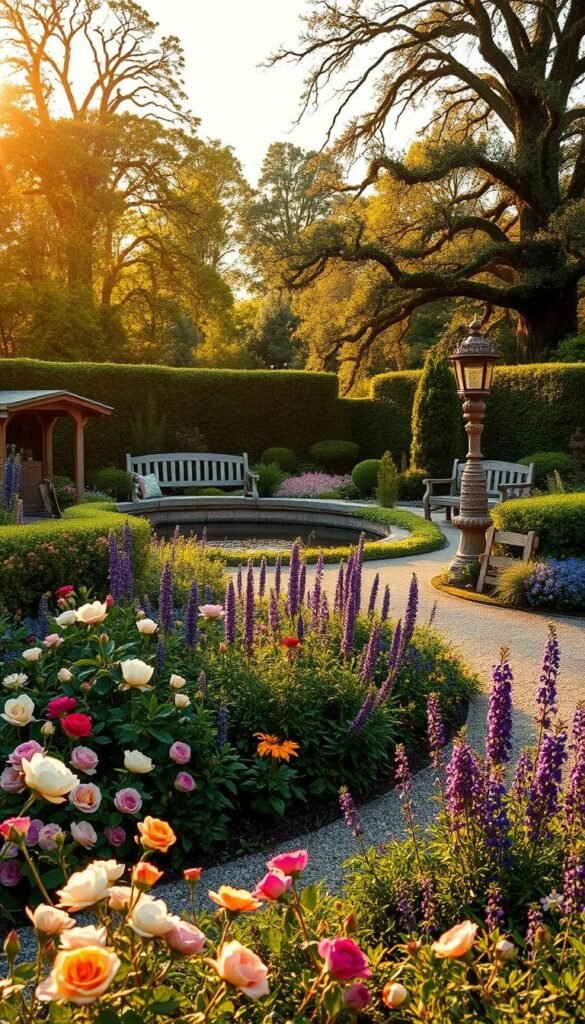Imagine stepping into an outdoor sanctuary where artistry and wilderness dance together. For centuries, these spaces have blended structured elegance with nature’s free spirit—think sculpted hedges framing wildflower meadows or stone paths winding through fragrant roses. This approach to shaping green spaces isn’t just about looks—it’s a philosophy that celebrates balance.
At its core, this style encourages working with nature rather than against it. You’ll find clipped evergreens softening beside billowing perennials, and reclaimed materials creating pathways that feel rooted in their surroundings. Discover how this country garden inspiration balances human creativity with ecological harmony.
What makes these landscapes endure? They tell stories. A weathered bench invites you to pause, while arching vines suggest hidden corners waiting to be explored. Whether you’re shaping acres or a small backyard, the principles adapt beautifully. Mix edible plants with ornamental blooms, or add vintage touches that whisper history into your modern space.
For those drawn to fairytale charm, the magic lies in details like dappled sunlight through fruit trees or pollinators buzzing among lavender. It’s not about perfection—it’s crafting a living canvas that evolves with the seasons while feeling effortlessly timeless.
Overview of English Garden Design Traditions
Picture a landscape where order and wildness coexist in perfect harmony. This is the heart of the english country garden approach—a garden style that pairs crisp hedges with overflowing flower beds and invites exploration through winding paths. At its core, it’s about blending human intention with nature’s spontaneity.
You’ll notice two main forces at play here. Structured elements like symmetrical layouts and stone pathways anchor the space, while loose plantings of roses, lavender, and ivy soften the edges. This balance creates depth and intrigue, making every corner feel both planned and pleasantly unexpected.
What sets these gardens apart? Three key traits stand out:
- Layered plantings that bloom in succession
- Materials that age gracefully, like weathered brick or mossy statues
- Spaces designed for both people and pollinators
Modern takes on this design philosophy thrive worldwide, from California courtyards to New England estates. By mixing local plants with classic features, you can adapt the look to your climate while keeping its romantic soul. The goal isn’t replication—it’s capturing that timeless dialogue between cultivation and wild beauty.
Exploring the Heritage of English Garden Design
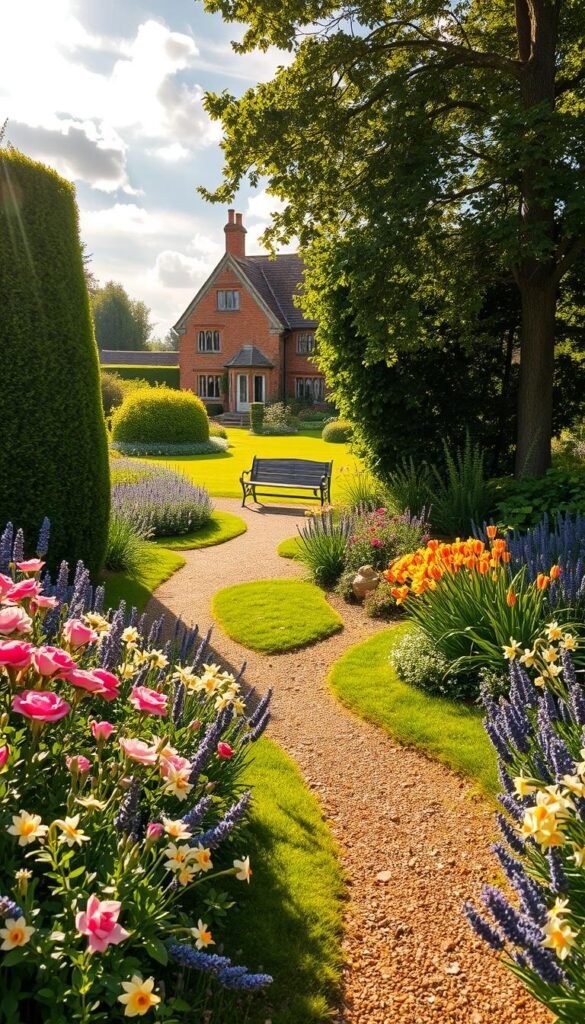
Travel back through centuries of green-thumb wisdom where practicality met poetry. The roots of english country gardens stretch beyond borders, thriving in places like New England vineyards or Australian estates. What makes them feel so settled? They borrow nature’s patience, looking like they’ve grown slowly over generations.
Medieval monks first blended herbs with beauty, crafting spaces for both healing and contemplation. By the 18th century, visionaries like William Robinson championed wilder plantings. His book The Wild Garden argued against rigid flower beds, favoring self-seeding blooms that mimic nature’s patterns.
Three historical shifts shaped this style:
| Period | Key Features | Influencers |
|---|---|---|
| Tudor Era | Symmetrical knots, medicinal plants | Monastic gardeners |
| 18th Century | Natural landscapes, ha-has | Lancelot “Capability” Brown |
| Victorian Age | Cottage gardens, mixed borders | Gertrude Jekyll |
You might recognize Jekyll’s color theories in modern parks—her layered drifts of lupines and delphiniums still inspire. These spaces mirror cultural values too. Winding paths suggest exploration, while ivy-covered benches whisper of leisurely afternoons.
Today’s versions thrive globally because they adapt. A California yard might swap hollyhocks for succulents but keep that time-worn charm. It’s not about copying—it’s capturing that soulful dialogue between human hands and earth’s rhythms.
Essential Elements of a Traditional English Garden
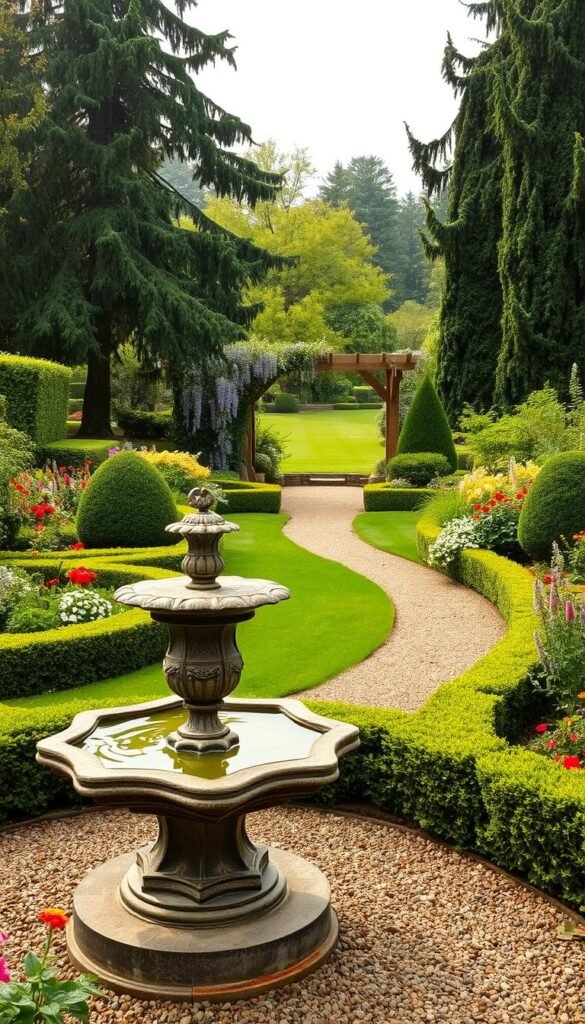
Creating a space that feels both intentional and wild requires mastering key components. The magic happens when architectural backbone meets nature’s spontaneity. Let’s explore how to blend these forces for a landscape that thrives in every season.
Symmetry & Structure
Start with a strong foundation. A central path or axis gives your space purpose, while curved edges soften the effect. Think boxwood hedges framing billowing peonies or stone walls supporting climbing roses. This balance creates rhythm without rigidity.
Diverse Planting Selections
Mix textures and bloom times for constant visual interest. Combine early tulips with summer phlox and autumn sedum. Here’s a smart approach:
| Structural Features | Planting Techniques | Visual Impact |
|---|---|---|
| Central axis path | Layered perennials | Year-round color |
| Arbors/archways | Rotating annuals | Changing textures |
| Defined borders | Self-seeding biennials | Natural abundance |
Deep borders let classic features shine. Allow 3-4 feet depth for plants to mingle. Tall delphiniums at the back? Perfect. Front them with shorter lavender and creeping thyme. Repeat key flowers every 10-15 feet to guide the eye.
Remember: spacing matters. Crowd plants slightly for that lush, overflowing look. Leave room for growth while maintaining air circulation. Your plants will reward you with healthier blooms and fewer pests.
Designing Your Landscape with English Garden Design Traditions: Classic Ideas for Timeless Landscapes
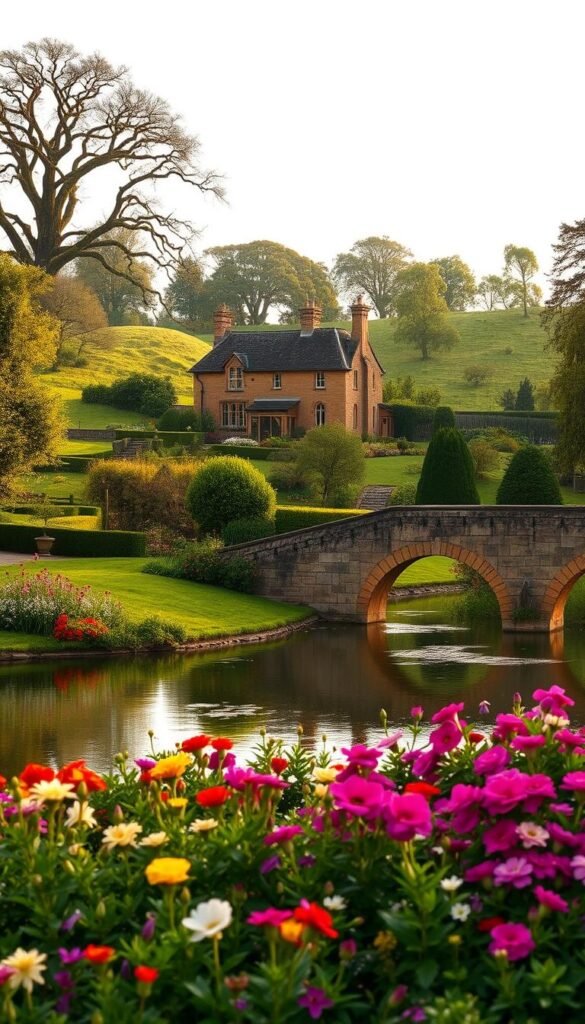
Transform your outdoor area into a living masterpiece that thrives in any climate. Whether you’re working with a balcony or acres, these design tips help you capture that romantic english country vibe without replicating weather conditions. Start by observing how sunlight moves across your space—this reveals where to place seating nooks or climbing plants.
- Use local stone for pathways to ground the design in your region
- Mix native perennials with classic roses for climate-smart charm
- Layer heights from ground covers to small trees for depth
Urban dwellers can borrow english country magic through vertical gardening. Train clematis up fire escapes or plant window boxes with herbs and pansies. One Brooklyn homeowner transformed a concrete patio using:
| Traditional Element | Modern Adaptation |
|---|---|
| Rose arbors | Steel frame trellises |
| Mixed borders | Self-watering planters |
| Gravel paths | Recycled glass pebbles |
Prioritize features that solve problems. A sloped yard becomes terraced flower beds. Narrow side yards gain purpose as scented herb corridors. Remember: “A garden should feel discovered, not declared.” Build your plan in phases—start with structural plants like boxwood, then add flowering layers season by season.
Crafting a Lush Planting Scheme and Year-Round Blooms
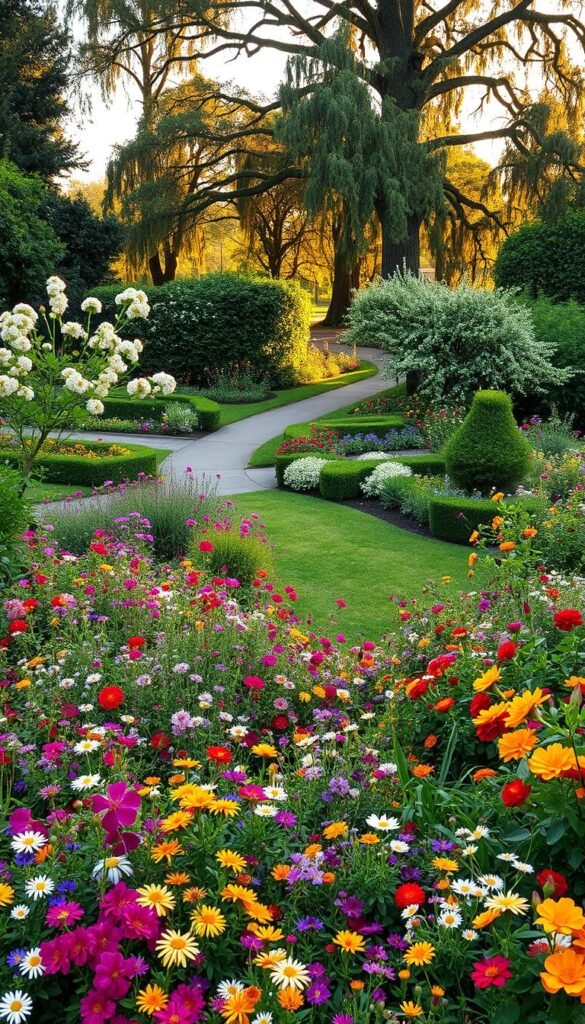
Imagine your space as a living tapestry where each plant plays a role in nature’s grand performance. The secret? Repetition with purpose. Grouping the same blooms in clusters creates visual rhythm—like foxgloves nodding in unison along a border or lavender repeating its purple haze across beds.
Start with perennials as your backbone. Peonies and hydrangeas return yearly, offering reliable structure. Pair them with self-seeding annuals like cosmos or poppies that fill gaps with cheerful spontaneity. This mix ensures your garden feels both curated and wild—a hallmark of creative gardening ideas rooted in timeless appeal.
Plan for seamless transitions:
- Spring tulips make way for summer phlox
- Autumn sedum takes center stage as roses fade
- Evergreen shrubs anchor winter scenes
Vary leaf shapes and textures to add depth. Combine spiky iris leaves with round hosta foliage, or let feathery astilbes contrast bold hydrangea blooms. Remember: succession planting isn’t just about flowers—it’s crafting moments. A well-timed clematis vine can cloak a trellis just as earlier blooms retire.
Pro tip: Let plants gently overlap. This creates that coveted “overflowing” look while suppressing weeds. Your garden becomes a self-renewing spectacle where every season unveils new actors on nature’s stage.
Integrating Climbing Roses and Fragrant Flowers
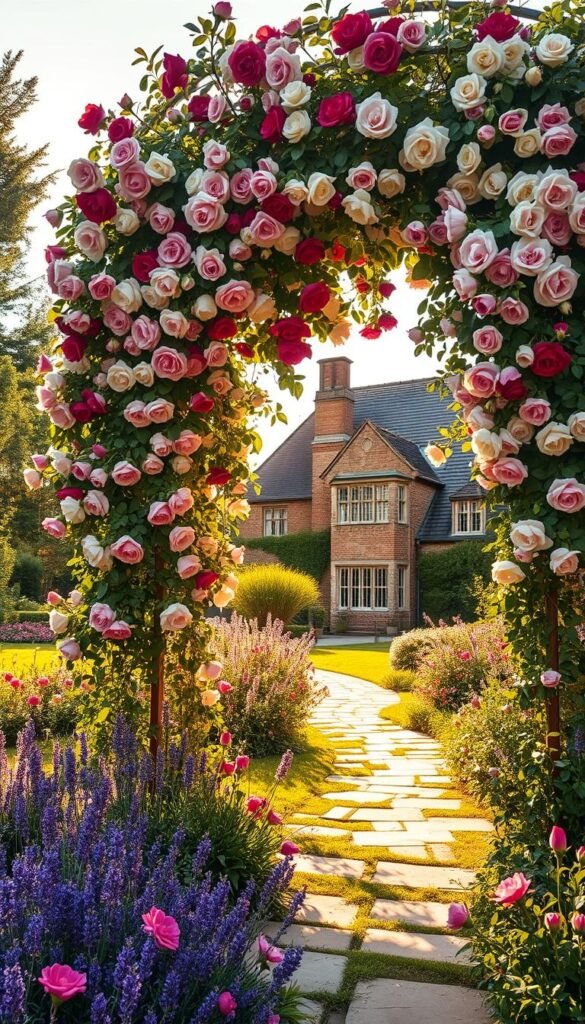
Envision vertical splashes of color that transform plain surfaces into living art. Climbing roses excel at turning walls and arbors into fragrant focal points, their cascading blooms softening stone or wood structures. Start by selecting varieties suited to your climate—heritage types like ‘New Dawn’ thrive in cooler zones, while ‘Lady Banks’ loves warmer areas.
Training these beauties requires patience. Guide stems horizontally along supports to encourage lateral growth, creating dense floral curtains. Pair them with scented companions like star jasmine or honeysuckle for layered aromas that shift through the day.
| Rose Variety | Key Features | Ideal Partners |
|---|---|---|
| Heritage Climbers | Strong fragrance, repeat blooms | Clematis, sweet peas |
| English Roses | Disease-resistant, lush foliage | Lavender, catmint |
| Modern Ramblers | Vigorous growth, single-season show | Wisteria, climbing hydrangea |
Prune strategically: remove dead wood in early spring while preserving flexible young canes. This maintains airflow and promotes flowering. For privacy screens, space plants 6-8 feet apart—they’ll fill the gaps within two seasons.
Mix shrub roses with perennials at ground level. Peonies complement pink varieties, while blue salvias make white blooms pop. Remember: let stems drape slightly for that effortless, romantic look everyone admires.
Utilizing Classic Stonework and Weathered Materials
Feel the crunch of gravel underfoot as you explore how stone elements shape outdoor spaces. These materials ground your landscape with stability while adding character that deepens over years. From moss-kissed walls to sun-warmed benches, each piece tells a story through texture and patina.
Start with functional features that do double duty. A dry-stack wall becomes both boundary and microclimate for alpine plants. Herringbone-patterned paths guide footsteps while showcasing craftsmanship. Consider these stone types for different needs:
| Material | Best Use | Aging Traits |
|---|---|---|
| Limestone | Walls & edging | Develops soft gray tones |
| Fieldstone | Pathways | Gains moss accents |
| Sandstone | Seating areas | Weathers to warm hues |
Let climbing plants partner with your stonework. Roses soften retaining walls, while ivy transforms plain surfaces into living tapestries. Space plants 12-18″ from walls to prevent moisture damage.
Balance is key. Pair rugged flagstone with airy grasses, or contrast smooth pebble mosaics with billowy hydrangeas. In dry climates, opt for local sandstone instead of moisture-loving slate. Your materials should feel rooted in place—like they’ve always belonged there.
Creating Meandering Garden Paths and Inviting Borders
What if every stroll through your yard felt like uncovering hidden treasures? Curved walkways guide visitors through your outdoor space, revealing surprises around each bend. The right combination of materials and plants turns functional paths into storytelling elements that engage the senses.
Choosing Path Materials
Gravel whispers underfoot, while weathered brick adds rustic charm. Consider your garden’s personality when selecting surfaces:
| Material | Best For | Maintenance |
|---|---|---|
| Crushed stone | Casual woodland areas | Annual topping |
| Reclaimed brick | Formal edges | Weed control |
| Flagstone | Gathering spaces | Moss management |
Vary widths to create rhythm—wider sections invite lingering, while narrow stretches feel intimate. For a timeless look, blend materials like stone stepping pads surrounded by pea gravel.
Designing Impactful Borders
Frame your paths with plants that soften edges while serving practical needs. Low-growing thyme releases fragrance when brushed, while dwarf boxwoods maintain crisp lines. Try this layered approach:
- Front: Creeping jenny (sparkling foliage)
- Middle: Catmint (pollinator magnet)
- Back: Hydrangeas (seasonal drama)
Install copper lanterns along borders for evening magic. Their warm glow highlights textures without overpowering the space. Remember: good borders solve problems—they prevent soil erosion while creating defined growing zones for your favorite blooms.
Incorporating Serene Water Features for Tranquility
Water whispers secrets of calm into every corner it touches. Whether it’s a stone basin catching raindrops or a burbling stream, these features bring rhythm to your space while supporting local wildlife. Start by considering scale—even compact courtyards can host a cascading urn or birdbath.
Selecting the Perfect Water Element
Match your water feature to your lifestyle and landscape. A recirculating fountain suits low-maintenance areas, while ponds create habitats for frogs and dragonflies. For modern sustainability, explore natural swimming pools that merge recreation with ecological balance.
Maintenance & Seasonal Considerations
Keep water clear with simple routines. Skim debris weekly and use barley straw to prevent algae. In colder months, protect pumps from freezing and let ice form naturally—it adds winter magic. Remember: moving water deters mosquitoes while inviting songbirds to sip.
Your garden becomes richer when water dances through it. A shallow stone bowl overflows with reflections by day and firefly glows at dusk. These living mirrors prove that serenity isn’t a luxury—it’s how nature connects us to the earth’s quiet pulse.

